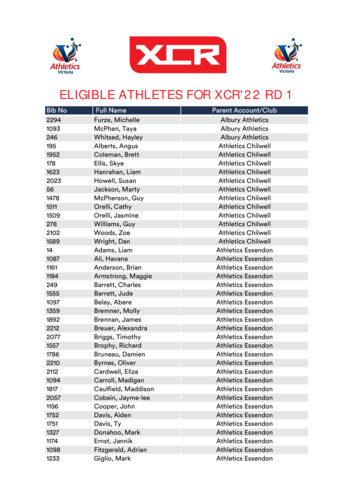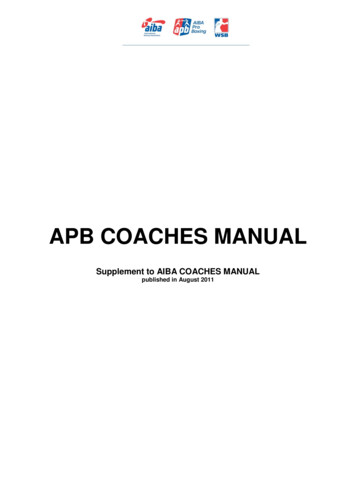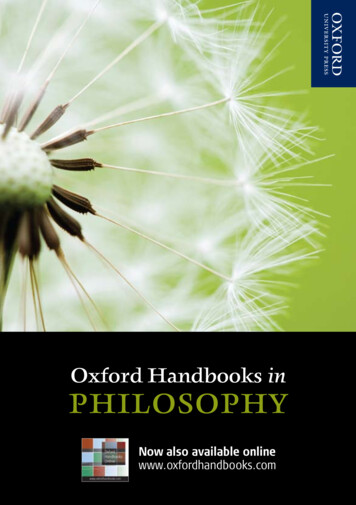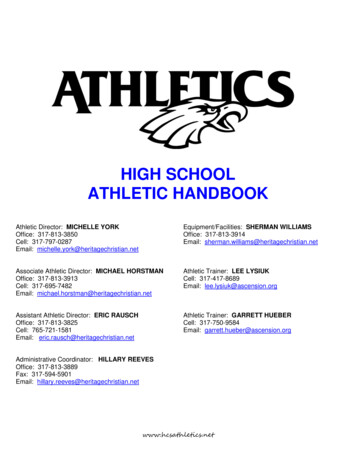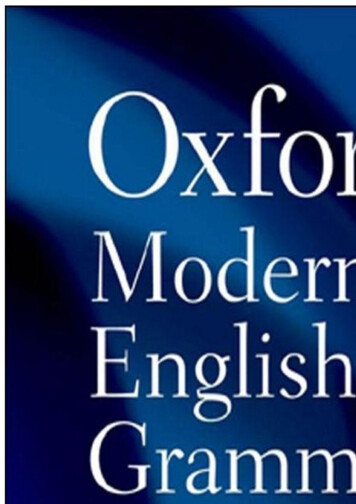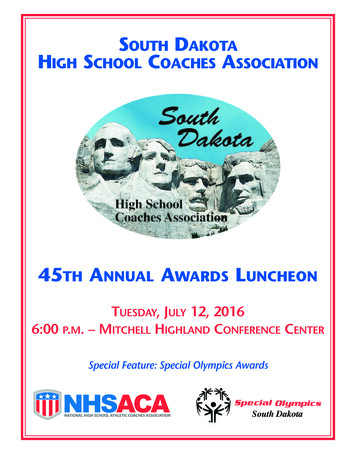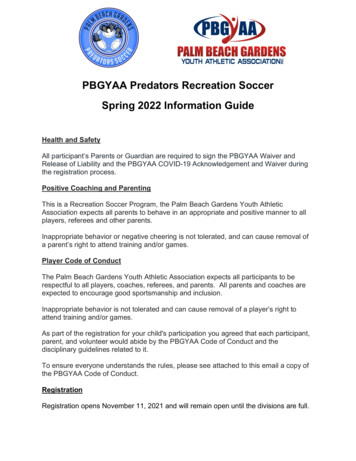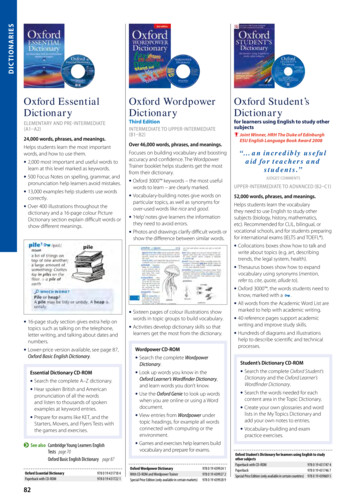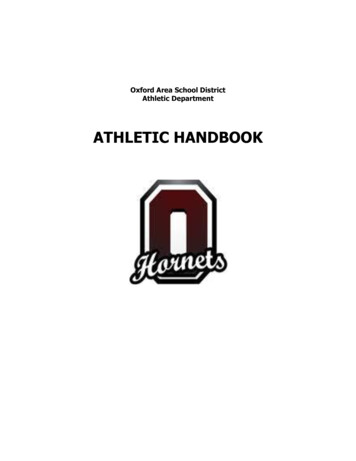
Transcription
Oxford Area School DistrictAthletic DepartmentATHLETIC HANDBOOK
Oxford Area School District Mission Statement:The mission of the Oxford Area School District is to have all students achieve academic excellence in asafe and nurturing environment. In partnership with families and the community, we will prepare eachstudent to be a confident, contributing, productive and responsible citizen.MANAGEMENT AND CONTROL OF ATHLETIC PROGRAMS FOR THEOXFORD AREA SCHOOL DISTRICTORGANIZATION:Board of School DirectorsSuperintendentAssistant SuperintendentBusiness ManagerDistrict Maintenance SupervisorHigh School PrincipalAthletic DirectorHigh School Assistant PrincipalsMiddle School PrincipalMiddle School Assistant PrincipalAssistant Athletic DirectorAthletic TrainersGame ManagersDISCRIMINATION POLICYThe Oxford Area School District is an equal opportunity education institution and will notdiscriminate on the basis of race, color, national origin, sex, handicap, age, or religion in itsactivities, programs or employment practices as required by Title VI, Title IX, and Section 504.OASD Website: www.Oxford.k12.pa.us2
TABLE OF CONTENTSINTRODUCTION .8PHILOSOPHY .8Interscholastic Athletics . 8Why Do You Coach? . 10What the School District Should Expect From You. 10What You Should Expect From the School District . 11ATHLETIC OBJECTIVES .11Program Objectives . 11Specific Objectives . 12Community Objectives. 12School and Student-Body Objectives. 13COACHES CODE OF ETHICS .13DUTIES AND RESPONSIBILITIES .13Responsibilities of Students . 13School Board of Directors. 15The Principal . 15Coaches and Athletics Personnel Duties (Legal) . 16BOOSTER CLUBS .20BUDGET RESPONSIBILITIES .20CAMPS/CLINICS .21CHES-MONT LEAGUE.21COLLEGE RECRUITING .22CUSTODIANS AND MAINTENANCE PERSONNEL .23DISCIPLINE PROCEDURES .23Suspension from a Team . 23Dismissal from a Team . 23Due Process . 23DUAL RELATIONSHIP .243
P.I.A.A. Eligibility for Interscholastic Sports . 24OASD Eligibility for Interscholastic Sports . 26Ineligibility . 27Home-Schooled Students Participation in Interscholastic Athletics . 27FACILITY MANAGEMENT .28FOREIGN EXCHANGE STUDENTS .29HAZING .29Definition and Perspective . 30Cultural Norm. 32Injuries and Death. 32Legislative Trends . 32Litigation . 33Implications for High School Athletic Personnel . 34Summary . 34HOLIDAY AND SUNDAY PRACTICES .35INFLUENCING BEHAVIOR .35IN-SEASON TEAM MANAGEMENT .35General Supervision of the Student-Athletes. 35Squad Limits and Squad Selection . 36Team Roster . 37Practice Sessions . 37Alumni Practicing with Current District Student-Athletes. 39Codes of Conduct . 39Equipment and Supplies . 40Procedures for Excuse from Class and School . 41Transportation Responsibilities . 41Van Driver Procedures . 42Assignment of Vehicles to Interscholastic Athletic Events . 42Meals and Lodging . 43Post-Season Tournament Expenses and Travel . 43Overnight Trips (Limited to Post-Season) . 434
Attendance Requirements for Practice and Competition . 44Student Procedures When Absent. 44Coaches Responsibility (In Determining Daily Attendance Eligibility) . 49LIGHTNING AND INCLEMENT WEATHER .49LOCKER ROOM SUPERVISION .50MANDATED REPORTING .50MEDIA RESPONSIBILITIES .50MEETINGS-LEAGUE AND RULES INTERPRETATION (P.I.A.A.) .51MULTIPLE SPORT PARTICIPATION .52MUSIC TAPES/CD’S FOR PRE-GAME WARM-UPS .52N.C.A.A. & N.A.I.A. ELIGIBILITY CENTERS .52OFF-CAMPUS TRAINING .53OFF SEASON OPEN GYM/FIELD/COURT/TRACK WORKOUTS.53PEP RALLIES .53PERSONAL PROPERTY (SECURITY OF) .54P.I.A.A. DISTRICT BOUNDARIES .54PLAYING TIME .55Middle School/Junior High . 55Junior Varsity and freshman . 55Varsity . 55Postponing Events . 55“PLAYING UP” .55POST SEASON DUTIES .56Season Summary . 56Student-Athlete Feedback Survey . 56Equipment Care and Inventory . 56Awards and Awards Banquets . 57Awards and Letters. 57Awards - Service . 58PRE-SEASON PREPARATION .595
Organizational Meeting . 59Document Approval . 60Pre-Participation Forms . 60Time-line for Submitting Pre-Participation Physical Examination Forms . 61PROFESSIONAL DEVELOPMENT/PROFESSIONAL GROWTH .61RELATIONSHIPS (COACH/STUDENT-ATHLETE/PARENT) . 62Formal Complaints and Procedure . 64District Procedure . 65RESIDENCY - (SCHOOL BOARD POLICY #202) .66SAFETY IN YOUTH SPORTS ACT AND SCA LAW.66Safety in Youth Sports Act, Senate Bill No. 200 . 66Sudden Cardiac Arrest Law for Youth Athletes – House Bill 1610 . 67SCHEDULES .67SCHOOL CANCELLATIONS/DELAYED STARTS/EARLY DISMISSALS/LATE BUS CANCELLATIONS .67SCRIMMAGES .68SCOUTING AND MEETINGS .68SEASON AND OUT-OF-SEASON P.I.A.A. RULES AND REGULATIONS .68SECURITY SERVICES .69SEXUAL HARASSMENT .70SOCIAL MEDIA .70SPECIAL EVENTS .71STORAGE/EQUIPMENT AREAS .71STUDENT MANAGERS .71TEAM WEBSITES .72TITLE IX – FEMALE PARTICIPANTS .72TRAINING RULES.72Rules and Regulations Regarding Substance/Tobacco/Alcohol Use For Athletes . 73VOLUNTEER COACHES .756
ATHLETIC TRAINING/INJURY MANAGEMENT .76Athletic Training Mission Statement . 76Athletic Training Staff . 76Athletic Training Room . 76Practice Coverage . 77Game Coverage. 77Medical Certification (for student-athletes) . 77Important Phone Numbers . 77Methicillin-Resistant Staphylococcus Aureus (MRSA) . 78Reporting of Injuries. 78Treatment of Athletes . 79Return to Play After an Injury . 81Athletic Training Room Policies . 81APPENDICIES“The most important thing in sports is not to win but to take part, just as the mostimportant thing in life is not the triumph but the struggle. The essential thing is not tohave conquered but to have fought well.” – Olympic CreedACCOUNTABILITY FOR MATERIAL CONTAINED WITHIN THE HANDBOOKAll coaches are accountable for all material contained within this handbook. Coacheswill be required to sign for receipt of their handbook and sign for acknowledgement ofaccountability. Any failure to follow protocol or violations of handbook procedures willbe processed in accordance to School Board Policy 417.7
ATHLETIC DEPARTMENT COACHES’ HANDBOOKINTRODUCTIONThis handbook has been developed to assist the coaching staff of the Oxford AreaSchool District in serving the students that elect to take part in the interscholasticathletic program. The Handbook contains athletic department procedures, regulations,and other information that will be helpful to coaches in administering, maintaining, andsupervising the athletic program.In addition to the materials presented in this handbook, all members of the coachingstaff must familiarize themselves with the rules of the sports they coach, as well as therules and regulations found in the constitution and by-laws of the PennsylvaniaInterscholastic Athletic Association.“Student First, Athlete Second”PHILOSOPHYINTERSCHOLASTIC ATHLETICSThe Board of School Directors believes that the purpose of an interscholastic athleticprogram is to provide learning experiences that will contribute to the personal, physical,and psychological development of the individual student athlete. These learningexperiences will be consistent with the educational goals of the Oxford Area SchoolDistrict as outlined in its Statement of Organizational Purpose and will complement theacademic program of the District. Hence, participation in interscholastic athletics canserve an important role in meeting the needs of secondary level students within thetotal educational process.The Oxford Area School District interscholastic athletic program is both voluntary andcompetitive and will be designed to meet the needs of student-athletes. In order toparticipate, student- athletes must be physically healthy, academically qualified, andwilling to make a significant personal commitment to maximize the development of theirknowledge, skills, and attitudes relative to the particular sport.All athletic teams will operate under the leadership supervision of an effective coachingstaff committed to accomplishing the educational goals of the school system. Membersof the coaching staff will employ safe and educationally sound techniques designed toactively promote the development of the student athlete as a whole person. Also,coaches will be expected to continually improve their coaching techniques throughparticipation in appropriate professional development programs.8
The school administration, especially the athletic director and the secondary principals,will provide a supportive environment for the coaches and student-athletes at all levels.All district administrators will be committed to the philosophy stated herein.The interscholastic athletic program will be increasingly competitive as student’sprogress from the junior high/middle school through the junior varsity to the varsitylevels. The earlier levels will serve as developmental programs for the more advancedlevels. Team goals will reflect these goals. Varsity coaches will work with junior varsityand junior high/middle school coaches to coordinate the developmental aspects of theprogram in each particular sport.At the (Penn’s Grove) junior high/middle school level of interscholastic competition,coaches will place a strong emphasis on instruction and on maintaining sufficient levelsof participation in that sport to allow the individual student athlete to develop his/herathletic potential. Participation and development of skills in a sport will be valued abovethe winning of contests. The needs of the team should be balanced with thedevelopmental needs of the individual team members. The number of participantsaccepted for membership on a team, however, must support this commitment to highlevels of instruction and participation.At the freshman/junior varsity level, instruction and the development of individualskills for all student-athletes will continue to be emphasized. However, team success ininter-school competition will also be valued. Student-athletes will become increasinglyaware of the importance of teamwork and a positive attitude toward team success.The number of student-athletes selected for the team will allow the coaches not only toinstruct and assist the participants in their individual development but also to teachteamwork as an important factor in interscholastic competition.At the varsity level of interscholastic competition, coaches will have the dualresponsibility of fostering individual skill development and achieving team success. Toachieve this end, the most effective student-athletes as judged by the coaching staff,regardless of grade level, will be given the opportunity to further develop their athleticabilities and to participate at the most advanced levels of interscholastic athleticcompetition. Coaching emphasis will be placed on helping the members of the team towork together and to develop a strong desire to attain the highest possible levels ofteam success.The Superintendent is directed by the Board of School Directors to develop,disseminate, maintain, and periodically revise the administrative procedures, includingbut not limited to handbooks for coaches and student-athletes, necessary to implementthe intent of this policy as well as an annual evaluation process for coaches.Appropriate professional development programs for coaches relative to this policy andthe above procedures will also be provided.9
WHY DO YOU COACH?Although a coach has their own specific reasons for coaching, the main reason shouldbe to take a group of young people and develop their individual and collective skills tothe maximum of their abilities. In addition, athletics as an extension of the classroomprovides a venue to education students socially, emotionally and mentally through thephysical. Student-athletes who are better players and better persons at the conclusionof their seasons or at the end of their careers than they were at the start have playedfor a successful coach, regardless of wins or losses.WHAT THE SCHOOL DISTRICT SHOULD EXPECT FROM YOU1. To serve as a role model for your student-athletes.influence you have on the young people in your charge.Never underestimate the2. To give an honest effort. To strive to do your best as you expect your studentathletes to do their best.3. To remember that how you treat and develop your student-athletes is moreimportant than how many games you win.4. Although participation in numerous school activities is encouraged for all students, itis understood that once a student-athlete commits to you the coach, and his/herteammates in that season of their participation as a member of the team,consequences for failure to abide by team rules may be implemented by the headcoach. All rules and consequences shall be pre-approved by the Athletic Directorand should be included in your handbook/rules packet distributed prior to theseason.5. To be supportive of the entire athletic program. Your student-athletes doappreciate it when you watch them compete in a sport other than yours.6. To conduct your program in an ethical manner.7. To keep athletics in perspective. To remember that although athletics is important,it is but a small component of a student’s total education.8. To have fun. It is indeed possible to work hard, be intense, and still enjoy everyminute of it.9. To be open-minded and receptive to recommendations and constructive criticismwhich you may receive from the school district.10
WHAT YOU SHOULD EXPECT FROM THE SCHOOL DISTRICT1. To provide you with the encouragement, support, and resources necessary todevelop the program.2. To remember that how you treat and develop your student-athletes is moreimportant than how many games you win.3. To conduct the overall sport program in an ethical manner.4. To be open-minded and receptive to recommendations and constructive criticismwhich the school district may receive from you.5. To keep athletics in perspective. To remember that although athletics is important,it is but a small component of a student’s total education.6. To provide you with opportunities and recommendations to help you grow as acoach. To offer criticism in a private setting.7. To support you against unfair and unfounded criticism and attacks.ATHLETIC OBJECTIVESThe athletic program is an integral part of the educational process of the Oxford AreaSchool District. It promotes a desire in our students and community to take part insports either as a participant or a spectator.Our aim is to develop competitive student-athletes but not to lose sight of educationalvalues such as sportsmanship, citizenship, health, character education and scholasticattainment. The athletic programs should also promote school morale and provide anadditional source of self-esteem for our students.PROGRAM OBJECTIVES1. To complement the primary function of the school, which is instruction.2. To represent the Oxford Area School District and its interscholastic athletic programin a positive and constructive manner.3. To strive for playing excellence that will produce successful teams within the boundsof a sense of fair play and mental health of the student-athlete.4. To provide opportunities for the individual's:11
Physical, mental and emotional growth and development. Acquisition and development of special skills in activities of each student’s choice. Development of desirable social traits such as loyalty, cooperation, and fair play. Development of leadership skills. Achievement of goals. Worthy use of leisure time. Practice of self-discipline, self-motivation, and fair play. Commitment to team goals over individual effort and recognition.SPECIFIC OBJECTIVES1. To provide opportunities to learn games and improve playing skills to the best oftheir abilities.2. To develop physical fitness and desirable health, hygiene and safety habits.3. To provide opportunities to make real friends with team members and widen circlesof friends by meeting student-athletes from opposing teams.4. To provide opportunities to observe and practice good sportsmanship.5. To realize that athletic competition is a privilege that carries definite responsibilitieswith it.6. To reap the benefits of the special type of discipline that comes from participationand competition.7. To understand the concept of teamwork and the individual’s role as a teammember.COMMUNITY OBJECTIVES1. The community should realize that control of and responsibility for school athleticsrests entirely with the school authorities.2. School athletics should furnish a recreational opportunity for the general public aslong as a community is willing to see that the program is conducted solely for thebenefit of student competition and student spectators.3. The community should judge the success of the season on the number ofparticipants, the number of spectators, new skills acquired and good citizenship andgood sportsmanship taught, rather than on the number of games won or lost.12
4. The community should constantly keep in mind that an athletic contest is part ofthe school program and therefore is governed by the same philosophy.SCHOOL AND STUDENT-BODY OBJECTIVES1. Athletics should be educational.2. Athletics should promote pride in one’s school and community.3. Proper student interest should be promoted.4. All visiting schools should be treated as guests.5. School policy should be consistently applied so as not to provide student-athleteswith special privileges.6. Sportsmanship, fair play and good school citizenship should be the goals of allstudent-athletes.7. Every effort should be made to provide the best coaching, facilities and equipmentpossible within the economic constraints of the school district’s budget.COACHES CODE OF ETHICSThe function of a coach is to educate students through participation in interscholasticcompetition. An interscholastic program should be designed to enhance academicachievement and should never interfere with opportunities for academic success. Thestudent-athlete's welfare should be uppermost at all times. Accordingly, the followingguidelines for coaches have been adopted by the National Federation of State HighSchool Association (NFHS):1.The coach shall be aware that he/she has a tremendous influence, for eithergood or ill, on the education of the student athlete and, thus, shall never place thevalue of winning above the value of instilling the highest ideals of character.2.The coach shall uphold the honor and dignity of the profession. In all personalcontact with student-athletes, officials, athletic directors, school administrators, thestate high school athletic association, the media, and the public, the coach shallstrive to set an example of the highest ethical and moral conduct.3.The coach shall take an active role in the prevention of drug, alcohol and tobaccouse.4.The coach shall avoid the use of alcohol and tobacco products when in contactwith players.13
5.The coach shall promote the entire interscholastic program of the school anddirect his/her program in harmony with the total school program.6.The coach shall master the contest rules and shall teach them to his or her teammembers. The coach shall not seek an advantage by circumvention of the spirit orletter of the rules.7.The coach shall exert his/her influence to enhance sportsmanship by spectators,both directly and by working closely with students, community, booster clubs, andadministrators.8.The coach shall respect and support contest officials. The coach shall not indulgein conduct which would incite players or spectators against the officials. Publiccriticism of officials or players is unethical.9.Before and after contests, coaches for the competing teams should meet andexchange cordial greetings to set the correct tone for the event.10. The coach shall not exert pressure on faculty members to give student-athletesspecial consideration.11. The coach shall not scout opponents by any means other than those adopted bythe league and/or state high school athletic association.DUTIES AND RESPONSIBILITIESRESPONSIBILITIES OF STUDENTSStudent's habits and reactions as spectators determine the quality of sportsmanship,which reflects upon the reputation of their school. Therefore, it is recommended thatthey:1. Know and demonstrate the fundamentals of sportsmanship.2. Respect, cooperate and respond enthusiastically to cheerleaders.3. Help to control the unruly behavior of fellow students.
MANAGEMENT AND CONTROL OF ATHLETIC PROGRAMS FOR THE OXFORD AREA SCHOOL DISTRICT ORGANIZATION: Board of School Directors Superintendent Assistant Superintendent Business Manager District Maintenance Supervisor High School Principal Athletic Director High School Assistant Principals Middle School Principal Middle School Assistant Principal
